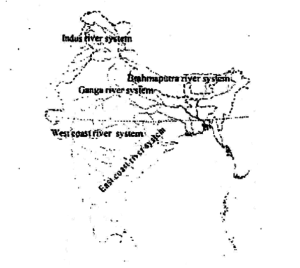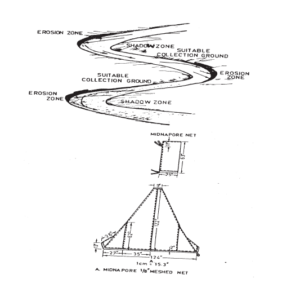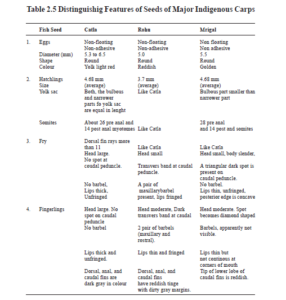2.1. Introduction
Fish seed is the most important component for fish culture. The freshwater resources of our country for fish culture are estimated to be 2.85 million hectares of pond and tanks. In addition to this, another 2.05 million hectares of water area is available in the form of reservoirs or lakes. It has been estimated that nearly 14250 million fry would be required for stocking even the present available cultivable resources of 2.85 million hectares on a conservative stocking rate of 5000 fry/ha. The present production is 15007 million fry. Apart from this, at least an additional quantity of 4100 million fry are required for stocking the available area of lakes and reservoirs with an average stocking rate of 2000 fry/ha. This indicates that there is a necessity to raise the fry to stock the available water resources.
The fish seed is obtained from 3 sources – riverine, hatcheries and bundhs. The collection of seed from riverine source was an age old practice. This method is strenuous and we get the mixture of wanted and unwanted fish seed. Hatcheries are the best way of getting fish seed. Apart from these, the bundh breeding is also a good method to collect the fish seed by creating a natural habitat.
The different river systems of India display variations with regard to the distribution and abundance of their fish fauna. This is mainly due to their individual ecological conditions, such as gradient, terrain, flow, depth, temperature, substrata, etc. The northern rivers are perennial and support rich commercial fisheries. Except for the deltaic regions, the fishery of the peninsular rivers is poor both in the upper and middle reaches.
2.2. Natural Seed Resources
2.2.1 Major River Systems
The different river systems of India display variations with regard to the distribution and abundance of their fish fauna. This is mainly due to their individual ecological conditions, such as gradient, terrain, flow, depth, temperature, substrata, etc. The northern rivers are perennial and support rich commercial fisheries. Except for the deltaic regions, the fishery of the peninsular rivers is poor both in the upper and middle reaches.
India has five major river systems (Fig. 2.1). These are : Ganga river system, Brahmaputra river system, The Indus river system, East coast river system and West coast river system.

Indian major riverine systems
Seed Procurement 15
2.2.1.1 The Ganga river system:
River Ganga covers the states of Haryana, Delhi, Uttar Pradesh, Madhya Pradesh, Bihar and West Bengal. The length of the Ganga river system is 8,047 km. It is the largest river and contains the richest freshwater fish fauna in India. The fish eggs are collected from the breeding grounds and downstream. Eggs are collected from 1-2′ deep water by disturbing the bottom and scooping them with a gamcha. The collection of spawn on a commercial scale is prevalent in these states alone contributing 51.9% of the country’s total production. The major carp spawn is available from May to September. The melting snow is responsible for floods and bring the carp spawn. The first appearance of spawn in India occurs in the Kosi followed by the main Ganga, Gomati and its other western tributaries. Billions of carp fry and fingerlings are caught in north Bihar from July to October.
2.2.1.2 The Brahmaputra river system:
It is found in the states of Assam, Nagaland, Tripura and comprises the fast flowing river, which distribute the commercially important major carps. Length of this river system is 4,023 km. The north-bank tributaries of Brahmaputra are comparatively large with steep shallow-braided channels of coarse sandy beds and carry heavy silt charge, while the south-bank are comparatively deep. The seed collection is made in this fast-flowing river with steep banks by fixing two long bamboo poles near the banks with a boat tied on to them across the current. The percentage of major carps are poor. The northern Gauhati centre investigated in 1969 revealed only rohu content of 9.58%. The river, being torrential and flashy due to steep gradients of its tributaries, changes its current pattern very rapidly, hence, the carp seed is less and difficult to collect.
2.2.1.3. The Indus river system:
It is rather rich when compared to the Brahmaputra river. The Beas and the Sutlej and their tributaries cover the states of Himachal Pradesh, Punjab and Haryana. There is no commercial fishery for major carps in Himachal Pradesh, with the upper reaches having cold water forms. Punjab is a good source for carp fishery. Length of Indus river system is 6,471 km.
2.2.1.4 East coast river system:
The rivers flow towards the east into the Bay of Bengal. It comprises the Mahanadi, Godavari, Krishna and Cauvery river systems. The length of east coast river system is 6,437 km.Mahanadi is the largest river of Orissa and the state’s only major source of fish seed. The river mainly harbours the hill stream fishes from its origin upto Sambalpur. Large number of spawn collection centres are identified between Sambalpur and Cuttack. Godavari and Krishna river system is the largest of the east coast river system, found in Maharashtra and Andhra Pradesh. No spawn collection centres exist in Godavari river in Maharashtra. The delta regions of these rivers are very abundant in fishes, but the percentage of major carp spawn is only 20.3% in the Godavari at Rajamundry. The upper regions of the Cauvery, being fast-flowing and sufficiently cool, are unsuitable for carp fishery, the middle and lower reaches harbour a fairly good fishery of major carps.
2.2.1.5 West coast river system:
The major rivers of the west coast are Narmada and Tapati, which are found in Madhya Pradesh, Maharashtra and Gujarat. Length of the river system is 3,380 km. The upper stretches of the rivers being rocky and unproductive, are not suitable for seed collection. The remaining parts are good for seed collection.
The major estuarine systems of India are the Hoogly-Matlah estuary of river Ganga, Mahanadi in Orissa, the Godavari-Krishna in Andhra Pradesh, the Cauvery in Tamil Nadu and the Narmada and the Tapati in Gujarat. The important brackishwater lakes of the country are the Chilka in Orissa, the Pulicat in Tamil Nadu and the Vembanad in Kerala. The common feature in the estuaries is the occurrence of horse-
Fig. 2.2 : The erosion and shadow zones of the river

shoe shaped sand bars at river mouths. Estuaries receive freshwater during the south-west monsoon months, from July to October. All the estuaries are good sources of freshwater and brackishwater fish and prawns.
2.2.2. Lakes and Reservoirs
Naturally formed lakes and man-made reservoirs constitute great potential fishery resources of India. Lakes and reservoirs are estimated to have an area of about 2.05 million ha. in our country. Important lakes in India are Chilka, Pulicat, Ooty, Kodaikanal, Nainital, Logtak lakes, etc. Important large reservoirs in India are Nagarjunasagar, Nizamsagar, Gandhisagar, Shivajisagar, Tungabhadra, Krishanarajasagar, Hirakud, Beas, Govindsagar, Ramapratapsagar, Bhavanisagar, Matatila, Rihand, Kangasabati, etc.
2.3. Collection of Seed from natural resources
Availability of fish seed in large quantities is a primary requisite to develop fish culture in India. Indian major carps Catla (Catla catla), rohu (Labeo rohita) and mrigal (Cirrhina mrigala) are preferred for cultivation in freshwater ponds and tanks throughout the country. Natural habitat of these Indian major carps is rivers, and there original spawning grounds are the flooded rivers. Since a long time traditional methods of collection of carp spawn and fry from those natural resources were built up, particularly in Bengal, which soon spread to other states of eastern India. Fish sed trade even today depends on this resource in few places.
With a view to providing scientific basis, seed prospecting investigations were initiated in various river systems of in India. Attempts wer made to standardise the spawn collection nets, to evolve methods of collection and to ascertain factors responsible for fluctuations in the availability of fish seed in relation to time and place.
2.3.1 Site Selection for Seed Collection
A pre-monsoon survey is conducted to ascertain the topography of the terrain and bank features at and in the vicinity of a site to determine the extent of operational area. The topography of dry beds and bank features to gauge the likely current pattern of the river at different stages of flooding. The distribution and composition of the fish fauna in the selected stretch of the river, resident or immigrant, for assessing the abundance of major carps during the monsoon season. The location of tributaries, rivulets and canals along with their main river, as they might constitute important connecting links between the river and breeding grounds. The identity and accessibility of the site. The bends and curves of various shapes in the river course often show a precipitous, fast eroding bank on one side called erosion zone and a flat, gently sloping bank exactly opposite called shadow zone (Fig. 2.2). These banks are not useful for spawn collection. Best seed collection sites lie on the side of the sloping bank but at the spot the current force the seed to the sides by centrifugal force. These spots are best to operate nets to collect large amounts of spawn.
2.3.2 Methods of Seed Collection
Generally shooting nets are used to collect the seed in the rivers. A shooting net is a funnel-shaped net of finely woven netting, and is fixed with the mouth of the net facing the current. It is operated in the shallow margins of a flooded river. At the tail end of the net, there is a stitched – inring of split bamboo or cane, and to this is attached, during the operation, a receptacle, termed the gamcha. A gamcha is a rectangular open piece of cloth. The seed moving along with the marginal current collects in the gamcha, and is stored in hapas or containers after removal.
Benchi jal is used to collect the seed in Bengal. Midnapur net is also used in Bengal, especially in the south-western parts, to collect the seed. The shooting net (Fig. 2.3) is fixed in line with the water current direction. The bamboo poles are fixed firmly at the selected site and the net is fixed to bamboo poles. Two bamboo poles are fixed near the mouth and other two poles are fixed at tail ring. The anterior end of gamcha is then tied round the tail ring. The gamcha is fixed in position with the help of two more bamboo poles.
In order to select the spot of maximum availability of spawn within a specified stretch of the river concerned, a number of trial nets are simultaneously operated at a number of suitable spots. After selecting the spot, the operation is started with full battery of nets. Once it is done, the collection from the tail piece of each net is scooped one after the other in quick succession every 15 minutes or depending upon the intensity of spawn. The contents of the gamcha are then scooped immediately in to a container half filled with river water. The collection is then passed through a mosquito netting sieve so that the unwanted organisms and non floating debris can be removed. The spawn are measured and kept in hapas for conditioning, then transported to fish farms and stocked in nurseries.
2.4 Factors effecting seed collection
Floods and water currend play an important role in the collection of seed.
2.4.1 Flood:
Floods show positive correlation with spawn. There may be three or more floods in a season. The pattern of flood is that the water first rises, then recedes. After few days again a second flood is caused and so on. Carps breed during floods in the rivers. In the first flood of the season the spawn of undesirable species is available. The major carp seed is available in subsequent floods. In between the floods the catches of major carp seed are less. The availability of spawn are linked with the floods. In the receding phase of the floods results in the draining of spawn out of the breeding grounds down the river. Spawn is available both during day and night ; more seed is found in night catches.
2.4.2 Water Current:
There is no effect on spawn when the water current is mild (0.086 km/hr). No significant effect is seen on spawn upto 0.4 km/hr water velocity. With increased water velocity all the spawn is carried away down the stream. The slow and gentle current velocity varying from 0.5-3 km/hr is the best to collect the spawn. While faster currents of the mid-stream carry little spawn, low velocities of less than 1 km/hr are unfavourable for spawn catch. In deeper parts of the river, the spawn is not available due to non-generation of floods.

2.4.3 Other Factors:
There is no effect of turbidity, pH and dissolved oxygen on spawn availability in the rivers. However, turbidity is associated with floods, and determines the efficiency of spawn collection. The turbidity reduces the mesh size of the net, and it is better to clean the nets at regular intervals. Air and water temperatures never show any effect on the spawn availability. The optimal temperature is 28-310C. Overcast conditions with breeze and with or without drizzle is found ideal for spawn collection. The stormy weather is totally unfavourable for spawn collection due to disorder currents and waves and the uprooting of shooting nets. Light also does not show any effect on spawn collection. The occurrence of plankton have no connection with the availability of spawn or its abundance in rivers. Spawn associations found abundant from the onset of monsoon dwindle thereafter to almost nil at the end of the season.
2.5. Seeds Seggregation :
Indian major carps seeds can be identified and seggregated with the help of characters as discribed in table 2.5
Summary
The fish seed is obtained from 3 sources – riverine, hatcheries and bundhs. The collection of seed from riverine source was an age old practice.
India has five major river systems. These are : Ganga river system, Brahmaputra river system, The Indus river system, East coast river system and West coast river system. Naturally formed lakes and man-made reservoirs constitute great potential fishery resources of India.
The bends and curves of various shapes in the river course often show a precipitous, fast eroding bank on one side called erosion zone and a flat, gently sloping bank exactly opposite called shadow zone. These banks are not useful for spawn collection. Best seed collection sites lie on the side of the sloping bank but at the spot the current force the seed to the sides by centrifugal force. These spots are best to operate nets to collect large amounts of spawn. Shooting nets are used to collect the seed in the rivers.
Floods and water currend play an important role in the collection of seed. There is no effect of turbidity, pH and dissolved oxygen on spawn availability in the rivers.
Source: Aquaculture
